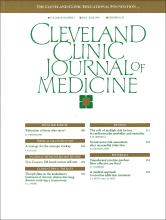Index by author
Gifford, Ray W.
- You have accessThe role of multiple risk factors in cardiovascular morbidity and mortalityRay W. Gifford, MDCleveland Clinic Journal of Medicine May 1993, 60 (3) 211-218;
BACKGROUND Cardiovascular disease remains the leading cause of death in the United States.
OBJECTIVE To identify important modifiable cardiovascular risk factors and appropriate interventions.
DISCUSSION The three most important modifiable risk factors are hypertension, cigarette smoking, and dyslipidemia. Systolic hypertension poses a greater risk than diastolic, but the prognostic significance of diastolic blood pressure may have been underestimated. When a smoker quits, the cardiovascular risk soon approaches that of the nonsmoker. Cardiovascular risk increases progressively with elevations of the serum total cholesterol level above 200 mg/dL. Recently identified risk factors include hyperinsulinemia and left ventricular hypertrophy.
CONCLUSION Each patient deserves an evaluation of cardiovascular risk followed by education about and therapy for those risk factors that can be changed. When more than one risk factor is present, as is often the case, the increase in risk may be synergistic rather than additive.
Goldschlager, Nora
- You have accessNoninvasive risk assessment after myocardial infarctionNora Goldschlager, MDCleveland Clinic Journal of Medicine May 1993, 60 (3) 245-251;
BACKGROUND Mortality from acute myocardial infarction is substantially less than it was two and even one decade ago. This improvement in both short-term and postdischarge outcome results both from early interventions to restore myocardial perfusion and mitigate expansion and remodeling, and from later assessment and management of functional status at the time of hospital discharge.
OBJECTIVE Recent studies suggest that invasive evaluation of the patient who has had a myocardial infarction (MI) should not be recommended on a routine basis. This review provides an approach to the noninvasive assessment of the patient.
DISCUSSION Stress testing to ascertain post-MI ischemia, ejection fraction determination to evaluate ventricular volumes and function, and ambulatory electrocardiographic monitoring, electrophysiologic study, and signal-averaged electrocardiography to assess presence and type of ventricular ectopy are discussed.
CONCLUSION The approach to the post-MI patient offered herein is felt to be medically sound and cost-effective. Refinement and alterations in this approach will be necessary as outcomes in specific patient groups, such as thrombolysis patients, women, and the elderly, become clearer.



